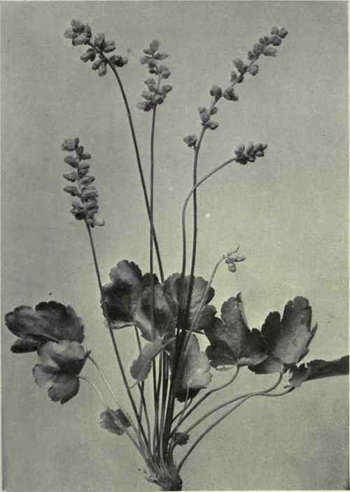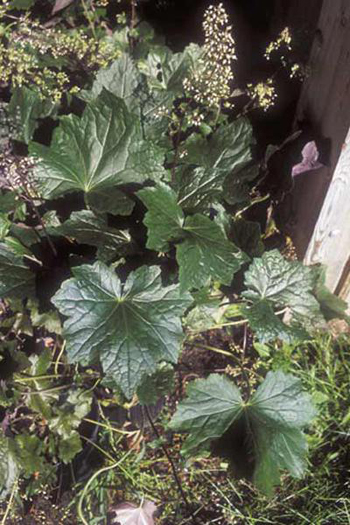Contents:
Common Names | Parts Usually Used | Plant(s) & Culture | Where Found | Medicinal Properties | Biochemical Information
Legends, Myths and Stories | Uses | Formulas or Dosages | Warning | Bibliography
Scientific Names

- Heuchera americana L.
- Saxifragaceae
- Saxifrage family
Common Names
- Alum
Parts Usually Used
Root, leaves
Back to Top
Description of Plant(s) and Culture

Alumroot is a perennial that grows to 1-3 feet; the leaves are toothed, roundish to somewhat maple-shaped, base heart-shaped. The flowers are small, greenish white, on short stalks; April to June.
Another variety: Another plant called alum root (Geranium maculatum) is also called storksbill, but in fact has no relation to Heuchera americana.
Back to Top
Where Found
Woods, shaded rocks. Southern Ontario, Connecticut to Georgia; Oklahoma to Michigan.
Back to Top
Medicinal Properties
Styptic, astringent
Back to Top
Biochemical Information
9 to 20% tannins and various unidentified substances
Back to Top
Legends, Myths and Stories
Not to be confused with cranesbill (Geranium maculatum) often called alumroot.
Native American uses: Alum root (Heuchera glabella) the Blackfeet called “Apos I poco,” the root was steeped for eye-wash. Another plant, (Huechera parvifolia), also called alum root, the root was pounded up and used wet to apply to sores and swellings.
Back to Top
Uses
Leaf tea used for diarrhea, dysentery, piles; gargled for sore throat. Root poulticed on wounds, sores, abrasions. Good for gastroenteritis, stomach flu, and dry bilious vomiting, douche for leukorrhea, vaginitis.
Back to Top
Formulas or Dosages
For dysentery, a cup of infusion may be taken every
No more than
Back to Top
Warning
Excessive use can cause gastric irritation and kidney and liver failure.
Back to Top
Bibliography
![]() Back to Eden
Back to Eden, by Jethro Kloss; Back to Eden Publishing Co., Loma Linda, CA 92354, Original copyright 1939, revised edition 1994
![]() Eastern/Central Medicinal Plants
Eastern/Central Medicinal Plants, by Steven Foster and James A. Duke., Houghton Mifflin Company, 215 Park Avenue South, New York, NY 10000
![]() Planetary Herbology
Planetary Herbology, by Michael Tierra, C.A., N.D., O.M.D., Lotus Press, PO Box 325, Twin Lakes. WI 53181., Copyright 1988, published 1992
![]() Indian Herbalogy of North America
Indian Herbalogy of North America, by Alma R. Hutchens, Shambala Publications, Inc., Horticultural Hall, 300 Massachusetts Avenue, Boston, Massachusetts 02115, 1973
![]() American Folk Medicine
American Folk Medicine, by Clarence Meyer, Meyerbooks, publisher, PO Box 427, Glenwood, Illinois 60425, 1973
![]() Indian Uses of Native Plants
Indian Uses of Native Plants, by Edith Van Allen Murphey, Meyerbooks, publisher, PO Box 427, Glenwood, Illinois 60425, copyright 1958, print 1990
![]() Webster’s New World Dictionary
Webster’s New World Dictionary, Third College Edition, Victoria Neufeldt, Editor in Chief, New World Dictionaries: A Division of Simon & Schuster, Inc., 15 Columbus Circle, New York, NY 10023
 How Indians Use Wild Plants for Food, Medicine & Crafts
How Indians Use Wild Plants for Food, Medicine & Crafts, by Frances Densmore, Dover Publications, Inc., 180 Varick Street, New York, NY 10014, first printed by the United States Government Printing Office, Washington, in 1928, this Dover edition 1974
 The Rodale Herb Book: How to Use, Grow, and Buy Nature’s Miracle Plants (An Organic gardening and farming book)
The Rodale Herb Book: How to Use, Grow, and Buy Nature’s Miracle Plants (An Organic gardening and farming book), edited by William H. Hylton, Rodale Press, Inc. Emmaus, PA, 18049., 1974
![]() The Yoga of Herbs: An Ayurvedic Guide to Herbal Medicine
The Yoga of Herbs: An Ayurvedic Guide to Herbal Medicine, by Dr. David Frawley & Dr. Vasant Lad, Lotus Press, Twin Lakes, Wisconsin, Second edition, 1988.
